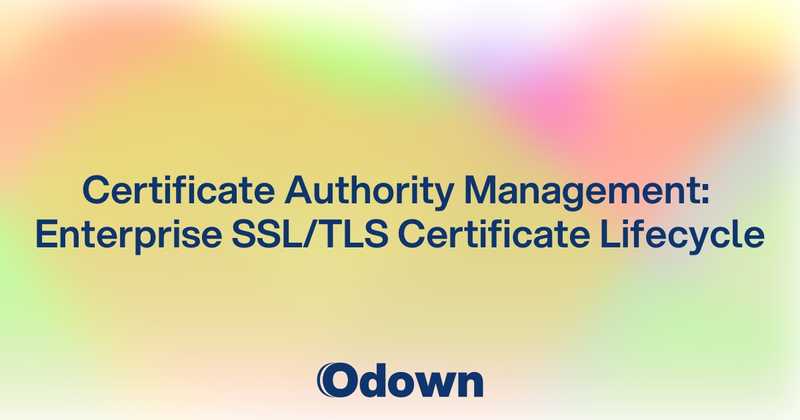Certificate Authority Management: Enterprise SSL/TLS Certificate Lifecycle
Your customers are greeted with a bright red "Your connection is not secure" warning when they try to visit your website. Your API endpoints are throwing SSL errors. Your team is scrambling to figure out what went wrong, and then someone realizes the obvious: your SSL certificate expired last night.
This exact scenario happens to major companies every month. Equifax, LinkedIn, and countless others have suffered embarrassing outages because someone forgot to renew an SSL certificate. It's the kind of mistake that makes you look incompetent even though the technical fix takes five minutes.
Enterprise SSL/TLS certificate management isn't just about buying certificates and installing them. It's about building systems that track hundreds or thousands of certificates across multiple environments, automate renewals before they become emergencies, and ensure your security posture stays strong as your infrastructure evolves.
The Hidden Complexity of Enterprise Certificate Management
Small websites might have one or two SSL certificates to worry about. Enterprise organizations often have hundreds. Web servers, API gateways, internal applications, microservices, development environments, staging systems - everything needs certificates, and they all expire on different schedules.
The problem gets worse as organizations embrace cloud computing and DevOps practices. New services get deployed constantly, each needing their own certificates. Development teams spin up environments that need temporary certificates. Microservices architectures multiply the number of endpoints requiring SSL protection.
Manual certificate management breaks down quickly at enterprise scale. Spreadsheet tracking becomes unreliable. Email reminders get ignored or go to people who no longer work at the company. Certificate installation procedures vary between different systems and teams.
The Real Cost of Certificate Problems
SSL certificate issues don't just cause embarrassing website warnings. They break API integrations that power mobile applications. They prevent automated systems from communicating with each other. They can even lock administrators out of management interfaces during critical incidents.
The business impact extends beyond technical problems. Search engines penalize websites with certificate issues. Customer trust plummets when browsers display security warnings. Business partners lose confidence when API integrations fail due to certificate problems.
Security risks multiply too. Organizations sometimes disable certificate validation to work around expired certificates, creating vulnerabilities that attackers can exploit. Teams might use wildcard certificates inappropriately because managing individual certificates is too complex.
Why Traditional Approaches Fail
Most organizations start with ad hoc certificate management that works fine initially but becomes unmanageable as they grow. Someone manually tracks certificate expiration dates in a spreadsheet. Renewal processes involve multiple teams and manual coordination. Certificate installation requires logging into servers individually.
This approach fails for several reasons. First, it doesn't scale. Managing ten certificates manually is tedious but possible. Managing a thousand certificates manually is impossible. Second, it relies on people remembering to do things, and people forget. Third, it creates single points of failure when only one person knows how to manage certificates for critical systems.
Cloud environments make traditional approaches even more problematic. Auto-scaling groups create and destroy servers dynamically. Container orchestration platforms deploy applications across multiple hosts. Traditional certificate management assumes static infrastructure that doesn't match modern deployment patterns.
Building Comprehensive Certificate Lifecycle Management
Effective enterprise certificate management requires treating certificates as infrastructure components that need automated lifecycle management, not as one-time configuration tasks.
Centralized Certificate Inventory
Start by building a complete inventory of every certificate in your organization. This includes public-facing websites, internal applications, API endpoints, development environments, and administrative interfaces. Don't forget about certificates embedded in mobile applications or used by automated systems.
Document not just what certificates exist, but where they're used, who's responsible for them, and what business functions depend on them. A certificate used by your payment processing system needs different management attention than one used by an internal development tool.
Include certificate metadata like issuing Certificate Authority, validation type, key strength, and any special features like Subject Alternative Names (SANs) or Extended Validation (EV) status. This information helps with renewal planning and security compliance efforts.
Update the inventory automatically whenever possible. Manual documentation becomes outdated quickly in dynamic environments. Use discovery tools that scan your infrastructure and identify certificates automatically.
Automated Certificate Discovery
Certificate discovery tools scan your infrastructure to find all SSL/TLS certificates currently in use. This helps maintain accurate inventory and identifies certificates that might have been forgotten or installed outside normal processes.
Network-based discovery scans IP ranges and ports to find services using SSL/TLS certificates. This approach finds certificates regardless of how they were installed or managed, but it might miss certificates that aren't currently active.
Agent-based discovery uses software installed on servers to inventory certificates stored locally. This provides more detailed information about certificate storage and usage but requires deploying agents to all systems.
Cloud-native discovery integrates with cloud platform APIs to enumerate certificates managed by cloud services. This works well for cloud-hosted applications but might miss hybrid or on-premises components.
Certificate Lifecycle Automation
Automate as much of the certificate lifecycle as possible, from initial provisioning through renewal and eventual replacement. Manual processes create opportunities for errors and delays that can cause outages.
Certificate provisioning should integrate with your infrastructure deployment processes. When new services get deployed, they should automatically receive appropriate certificates without manual intervention. This prevents the common problem of services launching with self-signed or invalid certificates.
Renewal automation requires coordination between certificate issuance, validation, and deployment processes. The renewal process needs to verify that new certificates work correctly before deactivating old ones. Rollback procedures handle cases where new certificates cause problems.
Decommissioning automation removes certificates when services get retired. This prevents accumulation of unused certificates that create security risks and management overhead.
Certificate Validation and Testing
Certificate validation goes beyond checking expiration dates. Validate that certificates match their intended usage, have appropriate security characteristics, and work correctly with client applications.
Domain validation ensures certificates are issued for the correct domains and don't include unauthorized names. This prevents certificates from being used inappropriately or creating security vulnerabilities.
Chain validation verifies that certificate chains are complete and valid. Incomplete certificate chains cause connection failures with some clients even though the end-entity certificate is valid.
Compatibility testing checks that certificates work with all client applications and browsers that need to use them. Different clients have different requirements for key algorithms, chain lengths, and certificate extensions.
Implementing Enterprise Certificate Authority Strategies
Large organizations need strategies for managing relationships with Certificate Authorities and deciding between different certificate types and validation levels.
Certificate Authority Selection and Management
Choose Certificate Authorities based on your specific requirements for validation types, certificate features, pricing, and integration capabilities. Not all CAs offer the same services or support the same automation protocols.
Establish relationships with multiple CAs to avoid single points of failure. If your primary CA has technical problems or policy changes that affect your operations, you need alternatives ready to activate quickly.
Monitor CA security practices and incident response. Certificate Authorities are attractive targets for attackers, and CA compromises can affect all certificates they've issued. Stay informed about CA security incidents and be prepared to respond if necessary.
Internal Certificate Authority Considerations
Some organizations operate their own internal Certificate Authorities for certificates used exclusively within their infrastructure. This provides more control over certificate policies and issuance processes but requires significant expertise to implement securely.
Internal CAs work well for device certificates, service-to-service authentication, and development environments where public CA validation requirements don't make sense. They're not appropriate for public-facing websites or services that need to work with external clients.
Operating an internal CA requires careful attention to security practices, key management, and certificate policies. Compromise of an internal CA can affect every certificate it has issued and potentially provide attackers with broad access to internal systems.
Certificate Policy and Compliance Management
Develop certificate policies that define appropriate certificate types, key strengths, and validation levels for different use cases. Public-facing e-commerce sites might require Extended Validation certificates, while internal APIs might use Domain Validated certificates.
Compliance requirements affect certificate management in many industries. Payment card industry (PCI) standards, healthcare regulations, and government security requirements all include certificate-related mandates that affect CA selection and certificate policies.
Document exception processes for cases where standard policies don't apply. Emergency certificate issuance procedures help respond to unexpected failures without compromising security standards.
Advanced Certificate Management Techniques
Large-scale certificate management benefits from advanced techniques that address the unique challenges of complex enterprise environments.
Certificate Transparency and Monitoring
Certificate Transparency logs provide public records of all certificates issued by participating CAs. Monitor these logs to detect unauthorized certificates issued for your domains and to track certificate issuance patterns.
CT log monitoring helps identify potential security issues like mis-issued certificates or certificate authority compromises. It also provides early warning when certificates are issued outside your normal processes.
Integrate CT monitoring with your security incident response procedures. Unauthorized certificates might indicate domain hijacking attempts, CA security issues, or internal process failures that need investigation.
Load Balancer and CDN Integration
Load balancers and Content Delivery Networks (CDNs) often handle SSL termination for multiple backend services. This centralizes certificate management but requires coordination between infrastructure and application teams.
Automated certificate deployment to load balancers and CDNs requires integration with their management APIs. Different platforms have different capabilities for certificate management and automation.
Consider using load balancer certificate management features that integrate with Certificate Authorities directly. This can simplify certificate lifecycle management for services that use centralized SSL termination.
Container and Orchestration Platform Integration
Container orchestration platforms like Kubernetes provide certificate management features that can simplify SSL/TLS configuration for containerized applications. These features often integrate with external Certificate Authorities and automate certificate lifecycle management.
Container-based certificate management requires different approaches than traditional server-based management. Certificates might be mounted as volumes, injected as environment variables, or managed by sidecar containers.
Service mesh technologies provide additional certificate management capabilities for microservices architectures. They can automate service-to-service certificate issuance and rotation without requiring application changes.
Monitoring and Alerting for Certificate Health
Proactive monitoring prevents certificate-related outages and ensures that certificate management processes work correctly.
Expiration Monitoring and Alerting
Monitor certificate expiration dates and alert well in advance of expiration. Different certificates might need different lead times based on their renewal complexity and business criticality.
Set up multiple alert thresholds - perhaps 60 days, 30 days, 14 days, and 7 days before expiration. This provides multiple opportunities to complete renewal processes and escalates urgency as expiration approaches.
Include certificate details in alerts to help responders understand what needs attention. Certificate Common Name, Subject Alternative Names, and usage information help prioritize response efforts.
Certificate Validation Monitoring
Continuously validate that certificates work correctly from client perspectives. This catches problems that might not be obvious from server-side monitoring, like incomplete certificate chains or compatibility issues.
Monitor certificate validation from multiple geographic locations and network paths. Regional network issues or CDN problems might affect certificate accessibility even when the certificates themselves are valid.
Test certificate functionality with different client types that represent your actual user base. Desktop browsers, mobile applications, and API clients might have different certificate requirements and error modes.
Security and Compliance Monitoring
Monitor certificate security characteristics like key strength, signature algorithms, and certificate authority trust status. Industry security standards evolve over time, and certificates that were acceptable when issued might become problematic later.
Track compliance with internal certificate policies and external regulatory requirements. Automated compliance monitoring helps identify policy violations before they become audit findings or security incidents.
Monitor for certificates that don't match your approved Certificate Authorities or validation processes. This might indicate shadow IT activities or security issues that need investigation.
Enterprise certificate management transforms from a necessary evil into a competitive advantage when done properly. Organizations with robust certificate management can deploy new services faster, respond to security incidents more effectively, and maintain customer trust through consistent security practices.
The investment in proper certificate lifecycle management pays dividends in reduced outages, improved security posture, and operational efficiency that lets teams focus on business value instead of certificate firefighting.
Ready to eliminate certificate-related outages? Odown provides comprehensive SSL certificate monitoring that tracks expiration dates, validates certificate health, and integrates with your existing infrastructure. Combined with our network outage prevention strategies and monitoring automation tools, you'll have complete visibility into your security infrastructure and the confidence that comes from knowing your certificates are properly managed.



